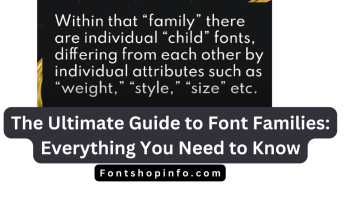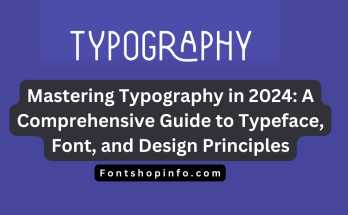Variable Fonts
One fascinating advancement in the large field of typography has gained prominence: Variable Fonts. Designers of all ages, including sixth-graders, will find the world of design to be lively and interesting thanks to these fonts, which offer a whole new degree of inventiveness and freedom.
Read Also Modern Fonts
This post will take you on a tour into the intriguing world of changeable typefaces, where you can discover more about their features, the technology that powers them, and the countless opportunities they present to let your creativity run wild.
Understanding Variable Fonts
With variable fonts, designers may now adjust a font’s weight, width, slant, and other attributes, which is a significant development in the field of typefaces.
Imagine a single typeface that fluidly changes to fit various sizes and styles. Multiple-axis typefaces, which effectively serve as the dimensions along which a font can alter, enable this adaptability.
The Technology Behind Variable Fonts
OpenType technology, which makes it possible to create fonts with numerous styles within a single file, is at the core of variable fonts.
With OpenType changeable fonts, designers have unmatched control over how their text looks. This innovation has created previously unheard-of levels of design flexibility, opening up a universe of possibilities.
Exploring Font Styles and Flexibility
Variable fonts give designers the freedom to personalize their works by introducing a vast array of font styles. The creative possibilities become almost endless when one has alternatives such as weight variation, width variation, slant variation, and even optical size variation.
This implies that you can design fonts within the same font family that are both subtle and beautiful or bold and striking.
Condensed and Expanded Fonts
Two variants that provide changeable fonts even more adaptability are condensed and enlarged fonts. Condensed fonts are ideal for designs when you need to accommodate more text in a constrained amount of area because they are narrower and take up less room.
Expanded typefaces, on the other hand, provide the impression of being bigger and more open, making a statement with a bold and roomy style.
Font Interpolation and Customization
One important aspect of changeable fonts is font interpolation, which facilitates seamless style transitions.
This makes sure that the text keeps its aesthetically pleasant and harmonious appearance even if you change the weight, width, or other variables. Creating custom fonts becomes easy because designers can adjust every detail to fit their style.
Dynamic Typography for Creative Expression
With dynamic typography—text that changes and adapts according to the demands of the design—variable fonts provide designers greater creative control.
This dynamic quality brings a creative element that brings your writing to life on paper or the screen. In addition to being visually captivating, dynamic typography is a playful means of expressing your original thoughts.
Type Design Technology and Innovation
A notable advancement in type design technology is represented by variable fonts. With every project, designers are free to explore and be creative instead of being constrained by strict typeface selections.
The evolution of typography is driven by this spirit of invention, which enables designers to push the envelope of creativity.
Web Typography and Graphic Design
Variable fonts affect more than just traditional print media. Variable fonts’ versatility is quite helpful for web typography since it makes for a visually appealing and consistent experience on a range of screens and devices.
Variable fonts can be used by graphic designers to provide eye-catching and responsive designs for websites, posters, and other visual products.
Variable Font Tools and Support
Designers can use specialized tools that provide user-friendly interfaces for adjusting font styles to get the most out of changeable fonts.
Major design applications and platforms now offer changeable typefaces, marking a considerable increase in support for the feature. This implies that flexible typefaces are simple to investigate and experiment with for designers of all ability levels, even sixth-graders.
Conclusion
Changeable typefaces are revolutionizing the design industry by enabling previously unthinkable levels of creativity and flexibility.
Variable typefaces offer an investigation and expressive space for all skill levels, from seasoned graphic designers to creative sixth graders.
Accept the dynamic quality of typography, try out various looks, and let your creativity run free in the colorful universe of changing fonts.
The process is just as thrilling as the final product, and every design project you work on will teach you new techniques to stand out in the always-changing world of typography.
FAQ
What are Variable Fonts?
Variable Fonts are an innovative development in typography, allowing designers to adjust various attributes of a font, such as weight, width, slant, and more. They offer a level of creativity and freedom that was previously unimaginable, making the world of design lively and interesting.
How do Variable Fonts work?
Variable Fonts operate on the concept of multiple-axis typefaces, providing dimensions along which a font can change. This adaptability allows a single typeface to fluidly adjust to different sizes and styles, offering designers unparalleled flexibility in their creative endeavors.
What technology powers Variable Fonts?
Variable Fonts are powered by OpenType technology, enabling the creation of fonts with numerous styles within a single file. This technology gives designers unmatched control over the appearance of their text, ushering in a new era of design flexibility and possibilities.
What are the key features of Variable Fonts?
Variable Fonts introduce a wide array of features, including weight variation, width variation, slant variation, and optical size variation. This flexibility empowers designers to personalize their work, creating fonts within the same family that can be both subtle and beautiful or bold and striking.
How do Condensed and Expanded Fonts enhance variability?
Condensed fonts are narrower and space-saving, making them ideal for designs where accommodating more text in a limited space is necessary. Expanded fonts, on the other hand, provide a wider and more open appearance, making a bold and spacious design statement.
What is font interpolation in Variable Fonts?
Font interpolation is a crucial aspect of Variable Fonts, facilitating seamless transitions between different styles. This ensures that text maintains a harmonious and aesthetically pleasing appearance, even when adjusting variables like weight, width, or other characteristics.
How do Variable Fonts support dynamic typography?
Variable Fonts enable dynamic typography, allowing text to change and adapt based on design demands. This dynamic quality adds a creative element, bringing the text to life on paper or the screen in a visually captivating and expressive manner.
How do Variable Fonts impact web typography and graphic design?
Variable Fonts have a significant impact on web typography, ensuring a visually appealing and consistent experience across various screens and devices. Graphic designers can leverage Variable Fonts to create eye-catching and responsive designs for websites, posters, and other visual products.
Are there tools available for working with Variable Fonts?
Yes, designers can use specialized tools with user-friendly interfaces to adjust Variable Font styles. Major design applications and platforms now offer support for Variable Fonts, making them accessible and easy to explore for designers of all skill levels, including sixth-graders.



